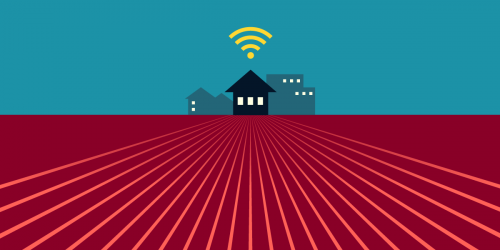The fight between the Federal Communications Commission’s choice to abandon the principles of net neutrality and the majority of Americans started early in 2017 and continued into the very last month of the year. But even with the FCC’s bad vote coming so late, we fought all year to build up momentum that will allow us to fix their blunder in 2018.
2017 started out with a warning: in his final address as chairman of the FCC, Tom Wheeler said that the future of a free and open Internet safeguarded by net neutrality was hanging by a thread. “All the press reports seem to indicate that the new commission will choose an ideologically based course,” said Wheeler. Wheeler also offered up the argument that “Network investment is up, investment in innovative services is up, and ISPs’ revenues—and stock prices—are at record levels. So, where’s the fire? Other than the desires of a few [providers] to be free of meaningful oversight, why the sudden rush to undo something that is demonstrably working?”
That would be a constant question posed throughout 2017: why would the FCC, under its new chairman, former Verizon lawyer Ajit Pai, move to eliminate something as functional and popular as net neutrality? After all, net neutrality protections guarantee that all information transmitted over the Internet be treated equally, preventing Internet service providers from prioritizing, say, their own content over that of competitors. It’s a logical set of rules that preserves the Internet as we know it. Net neutrality has been protected by the FCC for over a decade, culminating in the 2015 Open Internet Order, which we worked hard to get adopted in the first place.
As early as February, there were signs that the FCC was going to abandon its role guarding against data discrimination by ISPs. Early in the month, the FCC indicated it would cease investigating AT&T’s zero-rating practices. “Zero-rating” is when a company doesn’t count certain content against a user’s data limit. While zero-rating may sound good in theory, in reality it’s just your provider picking winners and losers and trying to influence how you use your data. AT&T was zero-rating content from DirecTV, which it owns. And, prior to Pai’s chairmanship, the FCC wanted to know if AT&T was treating all video service the same, in accordance with the principles of net neutrality. As Chairman, Pai abandoned the investigation.
The argument consistently put forward by opponents of net neutrality is that it imposes onerous rules on ISPs that stifle innovation and competition in the marketplace. The innovation claim is undermined by the many start-ups that lined up to defend net neutrality, telling the FCC that creativity depends on clear, workable rules. The competition claim is just as laughable, given that it is the large broadband companies that wanted net neutrality gutted—the same companies that are often the only option customers have. Net neutrality protections that forced monopolist ISPs to treat all data the same were some of the only competitive safeguards we had. Without them, Time Warner’s alleged practices of misleading customers and Internet content providers would lose the tempering effect the Open Internet Order provided.
On April 26, the fear and rumor became reality as the FCC chairman announced his intention to roll back the Open Internet Order and “reclassify” broadband Internet access so that ISPs would be allowed to block content and selectively throttle speeds, which was previously prohibited. We knew this was unpopular and would have a devastating effect on speech and the Internet, so we gave you a tool to tell that to the FCC. We knew that the vast majority of you support net neutrality, and we worked hard to make sure your voices were heard.
The new plan proposed by Pai claimed to make ISPs answerable to the Federal Trade Commission (FTC) instead of the FCC – even though a pending court case might keep the FTC from having any oversight of major telecommunications companies altogether. Even if it retains some authority, the FTC can only get involved when ISPs break the promises they chose to make—a flimsy constraint that telecom lawyers can easily write around. Sure enough, just as the FCC carried out Pai’s repeal, we saw Comcast roll back its promises on net neutrality. And that was just the start of the problems we have with Pai’s proposal. An attack on the open Internet is an attack on free speech, and that’s worth defending.
In June, we and a coalition of hundreds of other groups that included nonprofits, artists, tech companies large and small, libraries, and even some ISPs called for a day of action in support of net neutrality. That day came on July 12, when EFF and other websites “blocked” access to their websites unless visitors “upgraded” to “premium” Internet service, a parody of the real consequences that would follow the repeal of net neutrality. Our day of action resulted in 1.6 million comments sent to the FCC.
We kept busy in July, submitting our own comment to the FCC in strong opposition to the proposed repeal. Removing net neutrality protections would, we explained, open the door to blocking websites, selectively throttling Internet speeds for some content, and charging fees to access favored content over “fast lanes.” Our comment joined that of nearly 200 computer scientists, Internet engineers, and other technical luminaries who pointed out that the FCC’s plan was premised on a number of misconceptions about how the Internet actually works and how it is used.
Even with the comments from the engineers, the final version of the plan released by the FCC still contained incorrect information about how the Internet works. It became clear the FCC was forging ahead with a repeal, without stating a valid reason for doing so or listening to the voices of the public that were pouring in. With that in mind, we created a tool that makes it easy to tell Congress to protect the web and created a guide for other ways to get involved.
On December 14, the FCC voted 3-2 to roll back net neutrality and abdicate its responsibility to ensure a free and open Internet. That vote is not the end of the story, not by far. The new rule is being met with legal challenges from all sides, from public interest groups to state attorneys general to technology companies. Meanwhile, state governments have started introducing laws to protect net neutrality on a local level. Even as lawsuits begin, Congress can stop the FCC nightmare from going forward. Under the Congressional Review Act (CRA), Congress has a window of time to reverse an agency rule. This means that we, and you, must continue to monitor and pressure Congress to do so. So call Congress and urge them to use their power under the CRA to save the Open Internet Order.
This article is part of our Year In Review series. Read other articles about the fight for digital rights in 2017.









